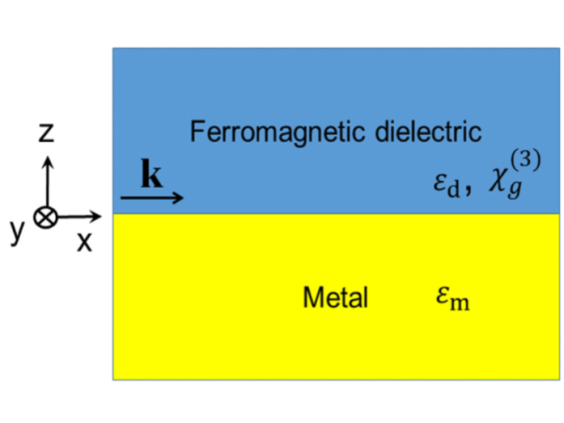Studies of nonlinear phenomena in magneto-plasmonic waveguides is of great interest, not only due to their fundamental importance but also because of potential applications in integrated nanoplasmonic devices for diverse functionality in chip-scale plasmonic communication systems. Recently, Dr. Joachim Herrmann (MBI) and his external collaborators predicted a new type of ultrafast nonlinearity of surface plasmon polaritons (SPP) in planar magneto-plasmonic structures, based on the inverse Faraday effect. Specifically they show that SPPs with a significant longitudinal component of the electric field can create, via the inverse Faraday effect (IFE), an effective transverse magnetic field in magnetic thin layers. Its response to the plasmon propagation leads to a strong ultrafast third-order nonlinearity. They estimate that the new nonlinearity exceeds the optical Kerr effect of typical dielectric materials by five orders of magnitude and that of gold by two orders of magnitude.
A magnetic material irradiated by circularly polarized light induces a magnetization along the wave vector. This effect is called the inverse Faraday effect (IFE). The sign of the light-induced magnetization is determined by the helicity of the incident light wave, and the magnetization vanishes for linearly polarized waves. Left- and right-handed circular polarization induces magnetization of opposite signs.
While light cannot penetrate into a thin metallic layer, under appropriate conditions surface plasmon polaritons (SPP) can be excited. These hybrid electron-photon excitations move along the metal surface. Since SPPs exhibit a longitudinal component of the electric field, even for a linearly polarized input beam a magnetization can be induced by the plasmons generated by the incident light, regardless that the plasmons are not circularly polarized in the conventional sense.
To quantify this new type of IFE-based nonlinear susceptibility in a planar plasmonic structure including a ferromagnetic layer, the group used the Lorentz reciprocity theorem, deriving analytical expressions. The new nonlinearity plays a similar role in the plasmonic propagation as the optical Kerr effect, but it originates from a different physical mechanism and differs from the traditional Kerr-related nonlinear susceptibility in magnitude, frequency dependence and the dependence on material parameters.
The scheme of a ferromagnetic dielectric/metallic interface is shown in Fig. 1. The wavelength dependence of the nonlinear propagation coefficient can be seen in Fig. 2 and the power dependence of the nonlinear phase shift in Fig. 3.
Magneto-plasmonic structures as building blocks open doors to a new class of plasmonic devices on the nanoscale, such as optical phase modulators, isolators and optical clocks that will satisfy key applications in nanoscale information networks. The new results are very promising for important applications in this field.
 | Wavelength dependence for the IFE-related nonlinear susceptibility for the interface between gold and a ferromagnetic dielectric. |
 | Power dependence of the nonlinear phase shift at a wavelength of 1550 nm and a propagation distance of 1000nm. |
Original-Publikation:
Song-Jin Im, Chol-Song Ri, Kum-Song Ho and Joachim Herrmann, “Third-order nonlinearity by the inverse Faraday effect in planar magneto-plasmonic structures”
Phys. Rev. B 96, 165437 (2017)
Kontakt
| Dr. Joachim Herrmann, Tel. 030-63921278 |


